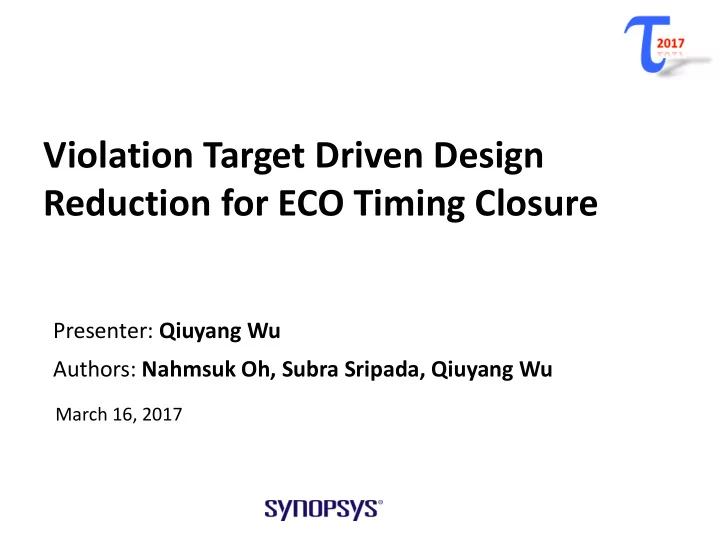

Violation Target Driven Design Reduction for ECO Timing Closure Presenter: Qiuyang Wu Authors: Nahmsuk Oh, Subra Sripada, Qiuyang Wu March 16, 2017
Timing Closure Efficiency is a Problem Resource required for timing closure is exploding Design sizes : 100M instance are common, approaching 1B instances Design complexities: modes, voltage combinations, temperatures, etc. Process variations: number of corners, device, wire, etc. Allocating many large machines to run in parallel is difficult Longer timing closure cycle Poor results with limited resources Demand to improve the ECO efficiency is high Need less memory, fewer machines, less disk space, and faster runtime TAU 2017 - Synopsys
What to Compromise: TAT or QoR ? Pick dominant scenarios for ECO Example: Use 100 scenarios in blocks, but 20 scenarios at top Pain: heuristics, may miss violations in dropped scenarios sub-optimal PPA, or non-convergent in signoff Serialize ECO runs Example: Perform ECO for the first 10 scenarios, then next 10 scenarios, and so on. Pain: Long ECO runtime, a ping-pong game among scenarios Poor quality, long cycle time Use huge machines or huge number of machines Example: merged or distributed MMMC aware framework Pain: max out computing farm - machine/disk/RAM/network, etc. prohibitive cost, long wait time Ultimately, TAT $$$ and QoR $$$ TAU 2017 - Synopsys
Observations from Design Practices Violations are usually clustered Bottleneck regions, partitions, paths Relatively small portion of the circuit is critical near the end Not all violations are equal Some large WNS paths maybe false or side-effects of incomplete data, constraints, etc. Some clock domains are more important than others Limited human attention span and scope Very hard to always look at all failures at any given time Natural divide-and-conquer to increase focus TAU 2017 - Synopsys
Violation Driven Design Reduction For a given set of violations to focus on, identify the minimum design to reproduce the timing Violating violation (e.g. end point with negative endpoint slack) , including Entire data fan-in logic cone to Fan-in the endpoint, up to all launch logic registers cone Entire clock network associated with all the launch registers of the above fan-in cone Entire clock network associated with the capture register Clock network Clock network TAU 2017 - Synopsys
Violation Driven Design Reduction For a given set of violations to focus on, identify the minimum FF1 design to reproduce the timing violation (e.g. end point with negative slack<0 slack) , including FF … Entire data fan-in logic cone to D the endpoint, up to all launch CP registers FFn Entire clock network associated with all the launch registers of the above fan-in cone Entire clock network associated with the capture register TAU 2017 - Synopsys
Ensure the Right Fixes Having entire data / clock fan-in logic enables tools / users to elect fixes The primary circuit are available to do ECO changes However, it takes more to validate and confirm fixes being right A right change fixes the target violation without causing other violations The ability to immediately and incrementally analyze and assess the full impact of a change is crucial for convergence Factors need to be considered such as Cross-coupling from and to logic outside of the base logic cone Slew propagation out of the logic cone Multi-instantiated blocks (MIM)
Fanout Load Extensions A change in the negative region can propagate its effect into positive region Slack>=0 Example, up-sizing the driver to fix setup violation cause faster slew into positive slack region and cause a hold violation. We can include the entire fanout cones … of the load fanout in the positive region FF D Leads to very large circuit potentially slack<0 Alternative (Clock path ignored) Capture required time at the load from positive region to reproduce slack Capture slack margin at the load to reject the change TAU 2017 - Synopsys
Cross Coupling Extensions We can include the entire fanin/fanout cones of the aggressor in the positive region Leads to very large circuit potentially We can capture the aggressor net info such as Slack>=0 Driver arrival windows, transition Aggressor wire parasitics Receiver cell slack<0 Changes inside negative region also FF … D impact the positive region CP Capacitance at receive output Required time at the receiver TAU 2017 - Synopsys
Multiply Instantiated Modules (MIM) Chip We can include the entire blk_inst_1 fanin cones and clocks of the same logic across instances slack<0 Leads to significant increase … of circuit size We can capture the essential timing data around positive instances blk_inst_2 Slack>0 Input port arrivals, slews, etc. Clock latencies, etc. CRPR, AOCV, POCV, etc.
Results Data -1 Memory Runtime Design Size Full Reduced X factor Full Reduced A 25M 45.7G 1.4G 33X 206 7 B 39M 64G 9G 7X 13626 10992 C 6M 10G 1.6G 6X 190 5 D 7M 16G 3G 5X 16956 8684 E 31M 56G 11G 5X 9625 5834 F 6M 16G 5.4G 3X 7061 5707 5-10X peak memory reduction 2-3 classes of machines TAU 2017 - Synopsys
Results Data -2 Runtime Initial Runtime Design violations Fix rate Full Reduced X factor A 21 100% 206 7 29X B 143190 99% 13626 10992 1.2X C 202 96% 190 5 38X D 73700 92% 16956 8684 2X E 17546 99% 9625 5834 1.6X F 10481 85% 7061 5707 1.2X 2-10X faster turnaround Many more ECO turns per working day TAU 2017 - Synopsys
Conclusion We presented a way to reduce a circuit by violation targets Applicable to cover timing/DRC/physical-aware fixes Significant improvement in memory and runtime with minimal impact to fix-rate/QoR Enables flexible focus on what to fix and productivity End points, clock domains, paths, etc. TAU 2017 - Synopsys
Thank you! TAU 2017 - Synopsys
Recommend
More recommend